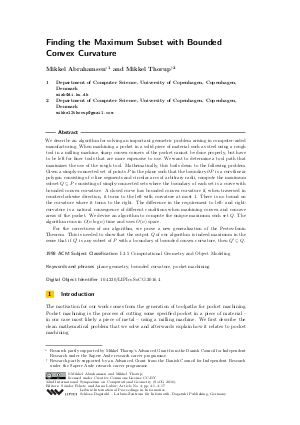Finding the Maximum Subset with Bounded Convex Curvature
Authors Mikkel Abrahamsen, Mikkel Thorup
-
Part of:
Volume:
32nd International Symposium on Computational Geometry (SoCG 2016)
Part of: Series: Leibniz International Proceedings in Informatics (LIPIcs)
Part of: Conference: Symposium on Computational Geometry (SoCG) - License:
 Creative Commons Attribution 3.0 Unported license
Creative Commons Attribution 3.0 Unported license
- Publication Date: 2016-06-10
File

PDF
LIPIcs.SoCG.2016.4.pdf
- Filesize: 0.59 MB
- 17 pages
Document Identifiers
Subject Classification
Keywords
- planar computational geometry
- bounded curvature
- pocket machining
Metrics
- Access Statistics
-
Total Accesses (updated on a weekly basis)
0PDF Downloads0Metadata Views
Abstract
We describe an algorithm for solving an important geometric problem arising in computer-aided manufacturing. When machining a pocket in a solid piece of material such as steel using a rough tool in a milling machine, sharp convex corners of the pocket cannot be done properly, but have to be left for finer tools that are more expensive to use. We want to determine a tool path that maximizes the use of the rough tool. Mathematically, this boils down to the following problem. Given a simply-connected set of points P in the plane such that the boundary of P is a curvilinear polygon consisting of n line segments and circular arcs of arbitrary radii, compute the maximum subset Q of P consisting of simply-connected sets where the boundary of each set is a curve with bounded convex curvature. A closed curve has bounded convex curvature if, when traversed in counterclockwise direction, it turns to the left with curvature at most 1. There is no bound on the curvature where it turns to the right. The difference in the requirement to left- and right-curvature is a natural consequence of different conditions when machining convex and concave areas of the pocket. We devise an algorithm to compute the unique maximum such set Q. The algorithm runs in O(n log n) time and uses O(n) space. For the correctness of our algorithm, we prove a new generalization of the Pestov-Ionin Theorem. This is needed to show that the output Q of our algorithm is indeed maximum in the sense that if Q' is any subset of P with a boundary of bounded convex curvature, then Q' is a subset of Q.
Cite As Get BibTex
Mikkel Abrahamsen and Mikkel Thorup. Finding the Maximum Subset with Bounded Convex Curvature. In 32nd International Symposium on Computational Geometry (SoCG 2016). Leibniz International Proceedings in Informatics (LIPIcs), Volume 51, pp. 4:1-4:17, Schloss Dagstuhl – Leibniz-Zentrum für Informatik (2016)
https://doi.org/10.4230/LIPIcs.SoCG.2016.4
BibTex
@InProceedings{abrahamsen_et_al:LIPIcs.SoCG.2016.4,
author = {Abrahamsen, Mikkel and Thorup, Mikkel},
title = {{Finding the Maximum Subset with Bounded Convex Curvature}},
booktitle = {32nd International Symposium on Computational Geometry (SoCG 2016)},
pages = {4:1--4:17},
series = {Leibniz International Proceedings in Informatics (LIPIcs)},
ISBN = {978-3-95977-009-5},
ISSN = {1868-8969},
year = {2016},
volume = {51},
editor = {Fekete, S\'{a}ndor and Lubiw, Anna},
publisher = {Schloss Dagstuhl -- Leibniz-Zentrum f{\"u}r Informatik},
address = {Dagstuhl, Germany},
URL = {https://drops.dagstuhl.de/entities/document/10.4230/LIPIcs.SoCG.2016.4},
URN = {urn:nbn:de:0030-drops-58960},
doi = {10.4230/LIPIcs.SoCG.2016.4},
annote = {Keywords: planar computational geometry, bounded curvature, pocket machining}
}
Author Details
References
- M. Abrahamsen and M. Thorup. Finding the maximum subset with bounded convex curvature, 2016. URL: http://arxiv.org/abs/1603.02080.
-
H.-K. Ahn, O. Cheong, J. Matoušek, and A. Vigneron. Reachability by paths of bounded curvature in a convex polygon. Computational Geometry, 45(1):21-32, 2012.

-
G.E. Blelloch. Space-efficient dynamic orthogonal point location, segment intersection, and range reporting. In Proceedings of SODA, pages 894-903, 2008.

-
S.-W. Cheng, O. Cheong, H. Everett, and R. van Oostrum. Hierarchical decompositions and circular ray shooting in simple polygons. Discrete and Computational Geometry, 32:401-415, 2004.

-
H.S. Choy and K.W. Chan. A corner-looping based tool path for pocket milling. Computer-Aided Design, 35(2):155-166, 2003.

-
X. Han and L. Tang. Precise prediction of forces in milling circular corners. International Journal of Machine Tools and Manufacture, 88:184-193, 2015.

-
M. Held. Voronoi diagrams and offset curves of curvilinear polygons. Computer-Aided Design, 30(4):287-300, 1998.

-
R. Howard and A. Treibergs. A reverse isoperimetric inequality, stability and extremal theorems for plane-curves with bounded curvature. Rocky Mountain Journal of Mathematics, 25(2):635-684, 1995.

-
H. Iwabe, Y. Fujii, K. Saito, and T. Kishinami. Study on corner cut by end mill. International Journal of the Japan Society for Precision Engineering, 28(3):218-223, 1994.

-
S.C. Park and Y.C. Chung. Mitered offset for profile machining. Computer-Aided Design, 35(5):501-505, 2003.

-
V. Pateloup, E. Duc, and P. Ray. Corner optimization for pocket machining. International Journal of Machine Tools and Manufacture, 44(12):1343-1353, 2004.

-
G. Pestov and V. Ionin. The largest possible circle imbedded in a given closed curve. Doklady Akademii Nauk SSSR, 127(6):1170-1172, 1959.

-
C.K. Yap. An O(nlog n) algorithm for the voronoi diagram of a set of simple curve segments. Discrete and Computational Geometry, 2(1):365-393, 1987.

-
Z.Y. Zhao, C.Y. Wang, H.M. Zhou, and Z. Qin. Pocketing toolpath optimization for sharp corners. Journal of Materials Processing Technology, 192:175-180, 2007.

